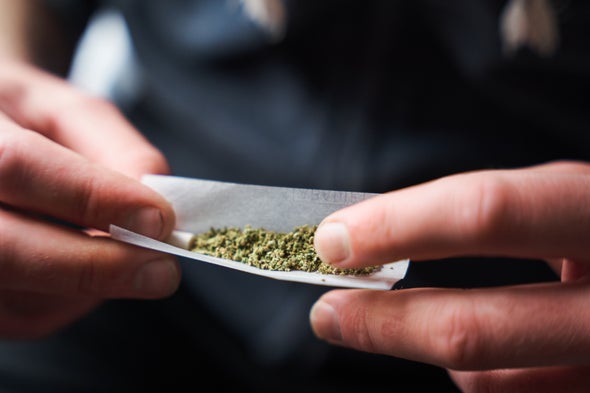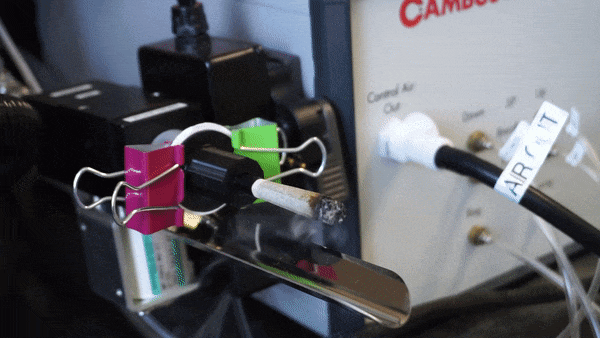
As cannabis becomes legal in more jurisdictions, it is increasing in popularity. The drug is currently consumed by 209 million global users. It is important for companies that sell legally authorized marijuana products to standardize their merchandise so consumers—including those who use it as medication—know exactly what they are buying. This means sellers must be able to measure the precise levels of cannabinoids, as well as contaminants, in their products. Some drug-delivery methods are harder to test than others, however. About 70 percent of cannabis users reported traditional smoking as their preferred consumption method in a 2022 survey conducted by the Canadian government. Manufactured prerolled cannabis joints represent a growing sector of the Canadian cannabis market, with industry research showing about 400 percent growth in the sale of “multipacks” prerolled products with a volume of two to five grams since 2021. Existing quality control techniques can measure the amount of active ingredients in each marijuana cigarette, but this overlooks an important variable: the physical mechanism of how the joint burns.
“There’s a lack of quantitative research on joint smoking. I want to understand what happens during inhalation on the chemistry side,” says Markus Roggen, president and chief science officer of Delic Labs, a cannabis and psilocybin research facility in Vancouver, British Columbia. Roggen and his colleagues questioned whether cannabinoid concentration was the most important factor in determining the drug’s intoxicating effect—and what other things contribute to an enjoyable experience. Their work was presented at the Canadian Chemistry Conference and Exhibition in Vancouver in June.
A joint is a simple device: the wrapping paper both holds the ground-up cannabis plant and channels smoke from the burning tip to the user’s mouth. Burning releases cannabinoid compounds from the plant particles in a gaseous form, allowing a smoker to draw them through the loosely packed material. Think of it as extracting and delivering gas-phase compounds at opposite ends of a tube. “This is an aerosol transmission problem at the interface between the joint and your mouth,” Roggen says. These aerosols contain marijuana’s active cannabinoid compounds—including intoxicant THC and cannabidiol (CBD), which is popularly believed to have calming and anti-inflammatory properties and is sometimes prescribed for intractable epileptic seizures.

To try finding the blueprint for the perfect joint, Roggen and his team prepared samples of both THC- and CBD-dominant cannabis strains. Using a coffee grinder and a sieve, they prepared batches of one-, three-, and five-millimeter-diameter particles. Then they made joints from 0.5 gram of each sample, pouring the particles into commercially available prerolled paper cones. Next they connected these joints to a “smoke cycle simulator” machine that uniformly “inhaled” six times for three seconds each, then “exhaled.” Filters collected the aerosols at the machine’s 3-D-printed mouthpiece, and the researchers used analytical chemistry techniques to measure aerosol levels from puffs taken at the beginning, middle, and end of each joint. (A human volunteer would have been in no condition to assess this many samples back-to-back.)
The amount of THC and CBD delivered by each joint suggested particle size does matter for intensity. For both cannabis strains, the 1-mm particle size delivered the most cannabinoid per puff, while the 5-mm size was less intense but led to longer-lasting joints. Smaller chunks exposed a greater surface area to the flame more quickly, providing a faster and more efficient burn. And regardless of particle size, the highest concentration of cannabinoids per puff came toward the end of the joint. Meanwhile more terpenes, chemicals in cannabis that contribute to flavor but not active drug concentration, came out of the plant at the beginning of the joint. This suggests that a joint will provide the best flavor at the beginning and deliver the strongest concentration of cannabinoids at the end.
Surprisingly, while the THC-dominant joints delivered a total of 19 to 28 milligrams of THC per cigarette, the CBD-dominant versions each delivered a whopping 90 to 100 mg of CBD—that’s 200 to 400 percent more of the dominant cannabinoid. “The amount of cannabinoid that gets to your mouth is higher for CBD than for THC,” Roggen says. “I cannot explain it, but I am very intrigued.”
Amber Wise, scientific director of the cannabis testing lab Medicine Creek Analytics in Fife, Wash., says manufactured prerolled cannabis joints represent a growing sector of the cannabis market and adds that manufacturers rely on automation to produce them. Because plant material is variable in terms of its chemistry, understanding the effects of particle size is important for product consistency. “Roggen’s data supports the argument that THC percentage matters less than particle size, and preroll manufacturers will find this useful,” she says. In addition, the new investigation’s researchers mention that critics and bloggers in the cannabis community often describe prerolls as tasting harsh or burning unevenly—and knowing more about how joint construction affects the delivery of terpenes could help manufacturers produce a better-tasting, more consistent product.
Additionally, doctors prescribe medical marijuana to be ingested in various formats, including joints. But prescribing a dose for smoked cannabis poses a problem Roggen hopes his research can help resolve. “If a doctor tells a patient to take three puffs daily,” he says, “what does that actually mean?”
Robert Strongin, a professor of organic chemistry at Portland State University, who was not involved in the research, agrees that the results illustrate steps toward a way to systematically regulate dosing. “This information could be particularly useful for medical marijuana patients and clinicians for whom dosing control and consistency is a significant issue,” he says. Roggen’s investigation provides a starting point for manufacturers to address issues relevant to quality control and to be able to manipulate the sensory, intoxicating and pharmaceutical effects of the resulting joint.
Further progress will require addressing variability that persisted in the team’s measurements—even between identically prepared joints. In future work, Roggen and his colleagues plan to examine how factors including humidity, combustion source and packing density influence a joint’s architecture and effects.
Wise points out that consumers want different things. Some buy small “dog walker” joints for a quick solo smoke without getting wrecked; others want longer-lasting ones for passing around at a party. “At the end of the day, I doubt preroll technology will market itself based on particle size,” she says. “But these studies are important because there’s a lot that we simply don’t know.”
ABOUT THE AUTHOR(S)
Rachel Berkowitz is a freelance science writer and a corresponding editor for Physics Magazine. She is based in Vancouver, British Columbia, and Eastsound, Wash.

